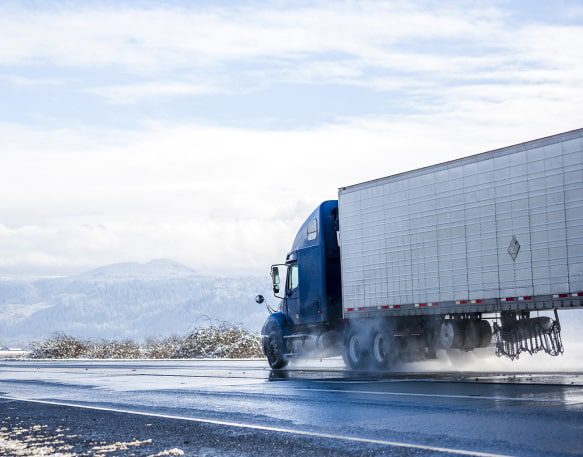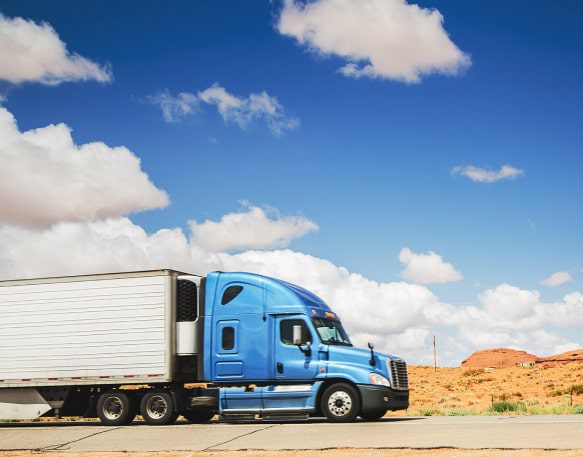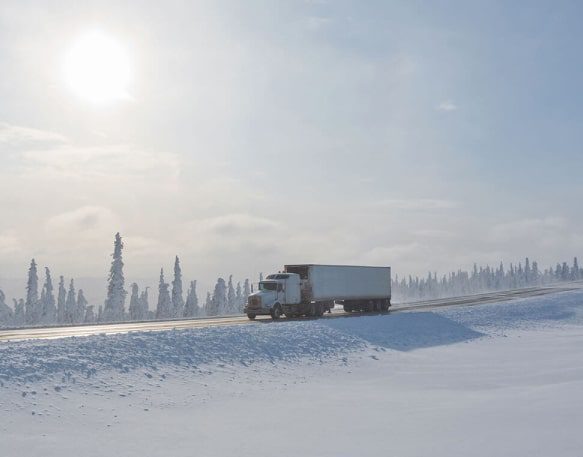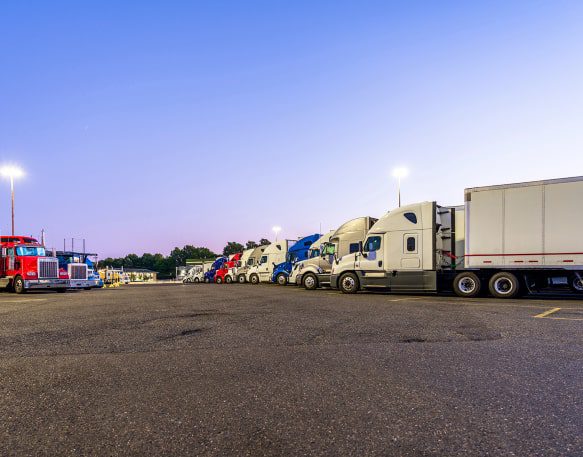by Alex Smith
In this guide, I will take you through the steps of how to start a hot shot business. You’ll learn:
- What is hot shot trucking
- Pros and cons of hot shot trucking
- How to start your hot shot business
- What equipment you’ll need
- How to find hot shot loads
- How to run a successful hot shot business
What Is Hot Shot Trucking?
When shippers and brokers have relatively small loads that need to be delivered quickly, they call upon the services of hot shot truckers. These drivers and operators specialize in delivering time-sensitive, project-critical loads like agricultural equipment, construction equipment and materials, heavy machinery, and more. Hot shot drivers typically operate super-duty pickups with trailers rather than heavy-duty, Class 8 semis.
When done right, hot shot trucking can be a lucrative business. You can choose to become an owner-operator — meaning that you own and operate a hot shot business under your own MC number — or you can lease on with another company. In this guide, I will walk you through the pros and cons of the business, how to get started, and a few insider tips for how to get ahead.
The Pros and Cons of Hot Shot Trucking
Hot shot trucking is often the starting point for many drivers. As insurance requirements become more and more strict, the Federal Motor Carrier Safety Administration (FMCSA) is trying to steer new drivers away from earning their commercial driver’s license (CDL) and then immediately buying a semi truck — a career move that often leads to failure.
Instead, the more strategic move is to build up driving experience on a hot shot truck while your CDL matures, that way if you decide to make the jump to a semi, you’ll have a much easier time getting qualified for insurance. Plus, the regulations and requirements for operating a hot shot and semi business largely overlap, so cutting your teeth in the hot shot world is the perfect preparation for making the leap to transporting larger freight (if that’s the career path you’re interested in).
Another significant advantage of hot shot trucking is that there’s a lower barrier to entry and lower operational costs. Truck payments, for example, can reach as high as $2,500-3,000 a month on Class 8 semis, but are often closer to $1,000 a month for pickups. Plus, smaller vehicles generally offer better fuel economy. This typically allows hot shot truckers to make as much as — if not more than — Class 8 drivers. These cost savings are often passed onto customers, as well. Because payments are higher for heavy-duty trucks like semis, those drivers and carriers naturally have to charge more for less than truckload (LTL) and partial freight so that the loads are worth their while.
However, because hot shot trucking is much easier to get into, you’ll be up against some pretty fierce and consistent competition. That’s why it’s important for owner-operators to really focus on quality of service to prevent competitors from underbidding.
How Do You Start a Hot Shot Trucking Business?
There are two primary disqualifiers in the trucking business: health and insurance. So before even opening your own LLC, it’s important to make sure that you won’t be blindsided by unexpected sky-high premiums or setbacks.
Anyone who drives a commercial motor vehicle, including hotshot drivers, must receive their Department of Transportation (DOT) medical card, so your first step is to schedule a physical examination from a medical examiner on the FMCSA-approved national registry. These examinations will cover basic things like your medical history and vision, hearing, and urine tests, and typically cost around $120. If you’re healthy enough, you’ll get your DOT medical certificate, which lets you operate commercial vehicles for 24 months. After 24 months, you will need to undergo another physical exam to renew your certificate.
The second thing I recommend is to get a commercial insurance test quote from Progressive, which only requires your Vehicle Identification Number (VIN). High insurance premiums can quickly eat into your profit margins, so having a ballpark quote is a useful way of determining whether it makes more sense to open your own LLC (i.e.. become an owner operator) or to lease on with another company. Insurance quotes are based on your driving experience and history — so if you just received your CDL or have a bad driving record, it’s likely that your insurance premiums will be through the roof, which makes leasing on the most viable path forward. Leasing on is often a good choice for new drivers, as it can help you get your footing more cost-effectively. But if you have more experience and your insurance premiums look good, you may want to go ahead with starting your LLC.
The next step is to open a business through your state’s website. They’ll give you an Employer Identification Number (EIN), which allows you to open a business bank account and receive payments from customers. Then you apply with FMCSA for a motor carrier or MC number (operating authority). This lets you cross state lines, and designate legal BOC-3 agents, who represent you in states you operate.
However, one of the biggest requirements for activating your MC number is commercial insurance. Most brokers require $1 million liability and $100,000 cargo insurance policies, which — depending on your experience, your age, and state of residence — could cost between $1,000 and $2,500 a month.
The process will take weeks, so it’s critical that your applications are filled-out properly and free of errors the first time around. That’s where the experts at DAT Authority can help — they specialize in handling paperwork for authority, federal and state permits, and state DOT regulations for hot shot trucks.
All told, hot shot trucking start up costs can easily reach the $15,000-30,000 range, but this will vary based on personal circumstances. If you already own a truck, for example, then you just need a trailer and the various legal fees. However, if you don’t already have either a truck or trailer, you’re now responsible for a $5,000 down payment on your truck, $10,000-15,000 for a trailer, and $3,000 for insurance down payments, on top of the ballpark $1,000 needed for your LLC and the other fees listed above — all of which can quickly drive up your startup costs.
The Equipment Needed for Hot Shot Trucking
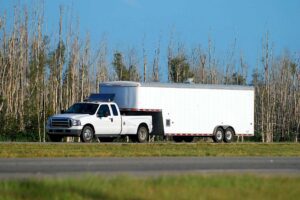 First and foremost, hot shot truck drivers need a pickup truck and some kind of flatbed trailer for hauling loads. I recommend getting a dually pickup truck, but that comes down to personal preference. For trailers, bumper pull, gooseneck trailers, tilt deck and dovetail all have their own advantages and disadvantages depending on what you’re hauling. Beyond that, straps, chains, and tarps are a few of the bare essentials. You don’t need particularly heavy-duty chains when driving hot shot because your weight won’t ever be high enough that it would require something really thick. Tarping is a skill that has a little bit of a learning curve (think of it like wrapping a very large Christmas present), but is useful for keeping freight dry.
First and foremost, hot shot truck drivers need a pickup truck and some kind of flatbed trailer for hauling loads. I recommend getting a dually pickup truck, but that comes down to personal preference. For trailers, bumper pull, gooseneck trailers, tilt deck and dovetail all have their own advantages and disadvantages depending on what you’re hauling. Beyond that, straps, chains, and tarps are a few of the bare essentials. You don’t need particularly heavy-duty chains when driving hot shot because your weight won’t ever be high enough that it would require something really thick. Tarping is a skill that has a little bit of a learning curve (think of it like wrapping a very large Christmas present), but is useful for keeping freight dry.
I usually recommend hot shot truckers have 20 straps with ratchets; four 20’-long 3/8″ chains in your truck, along with four binders and a winch bar; and two 6’ drop tarps.
How to Find Hot Shot Trucking Loads
Hot shot freight is time-sensitive and companies are going to be looking for trucks in their area that are able to pick up loads and get on the road ASAP — which makes load boards the most efficient method for truckers to easily find hot shot freight.
While using a smaller load board might seem like a tempting way for how you can get loads for hotshots, especially for operations that work locally or regionally, these tools often aren’t worth it because they tend to be much more limited in terms of options. DAT’s load boards are one of the most comprehensive freight networks around, and they make it simple to search for hot shot freight. You can save your favorite routes and lanes for quick searches later, and if you’re looking for loads in a specific geographic area, you can set up alarms so you’ll be notified when a match turns up.
The majority of listings on DAT’s load boards are posted by hot shot trucking brokers working on behalf of shippers, and the system also provides you with information like brokers’ credit scores and average time to pay, which can be helpful for making sure you’re working with the right partners.
How Do You Run a Successful Hot Shot Business?
A couple of general recommendations I give up front are to run loads over the weekends (they pay more), and to stick it out for at least three years. That might sound like a long time when you’re just starting out, but I’ve got a few other suggestions that’ll help you get your footing as quickly as possible.
One rule to follow is “half the weight, half the rate.” That means if a load takes up about half of what I can carry (either half of my weight capacity or half of my actual space), then it should pay about half of the rate per mile that I’m trying to achieve. So if I’m trying to achieve $2 a mile (which is a good standard) with a 40’ trailer and 9,000 pounds of capacity, a load that’s 4,500 pounds in 20’ or fewer has to pay at least $1 a mile. The cost of operating a hot shot is typically around $0.75-0.80 per mile (though it will of course vary based on individual payments), and the advantage of “half the weight, half the rate” is that allows the first half of the load to cover my expenses. Whatever rate per mile I land for the other half of the trailer is basically profit in my pocket at that point.
One mistake people make is not maximizing their clock. The more driving you put in, the more you get out — while making sure to follow the Hours of Service regulations. Trucking tends to run long hours anyway (which can leave little to no time for things like side hustles or working toward a degree), and it’ll take a little while to learn how to work your shift most effectively, how to plan your week, and which areas to avoid to prevent driving home empty (deadhead). That sort of on-the-ground knowledge that’ll help you make smarter business decisions has to be learned by putting the time in and putting the miles down.
It’s also important to keep in mind that hot shot trucking is a numbers game. You’re not going to make one phone call and get a good load right away. The faster you make 20 phone calls, the more likely you are to find a high-paying load. The same thing goes for your driving experience — the faster you can put in 100,000 miles, the more you’ll learn which areas are best for finding loads. If you’re just starting out, DAT offers a free weekly report called Trendlines that will give you a taste of what’s happening in the truckload market. As you get more experience, you’ll also get a better sense of what you should be charging, which will help with quoting better prices to brokers and customers so you’re not operating at a loss.
The Right Tools for Success
While finding the right resources and support may not be for everyone, independent truckers can benefit from joining industry organizations that support owner-operators in managing various aspects of their business, from navigating DOT regulations to handling everyday operational needs.
For those seeking an efficient, all-in-one solution, the DAT One platform offers access to DAT’s load boards along with tools like factoring services, load tracking, operating authority services, fleet compliance options, and more. With a free mobile app, truckers can manage these processes and access the latest truckload rate data to ensure competitive pricing on loads.
Another tool that can help you run and manage your business much more efficiently is a spreadsheet software called Airtable. Instead of having one application for inputting loads, another for tracking expenses, and third for generating invoices, Airtable allows you to manage those aspects of your business all from the same program. That way, load information feeds directly into your invoices while also keeping your expenses up to date. Airtable is available for free for essential features, and then subscription plans go for $10 or $20 per month for additional data and services.
Once you learn how to use it, Airtable is one of those highly customizable tools that can really empower small businesses in a variety of ways. For instance, I’ve been using Airtable to build a job application form. If someone wants to come work for me, they just have to upload pictures of their driver’s license and medical card. At that point, I’ve collected the documentation needed for a real job application — and they don’t actually have to fill out any additional paperwork. This saves new applicants from filling out multiple repetitive forms, and if I do end up hiring them, I already have all their paperwork on file.
Final Thoughts
Ultimately, there is no secret sauce to hot shot trucking — you just have to put in the time and build up experience. That said, if you have a sound strategy and take advantage of the right tools, you can make smart business decisions and be sure that your company is properly supported and set up to succeed.
About Author
Alex Smith runs a hot shot trucking business called Tow Piglet LLC. He is also a popular trucking influencer on YouTube and Instagram, regularly posting videos on how to get started in the industry. Alex is based in Texas and is the proud father of two young daughters.
Get Started Today!
Get the most relevant matches for your business – the right load for the right truck at the right price, no matter where you are. DAT is the largest load board, with more than 235 million loads posted annually. Find the load board package that best suits your business.

